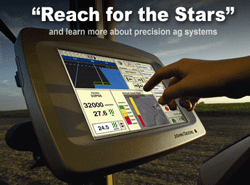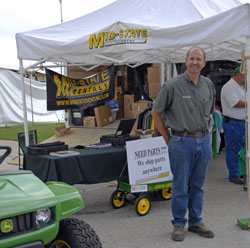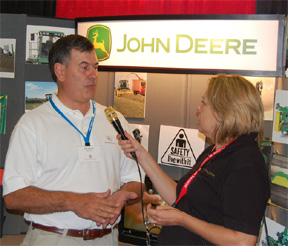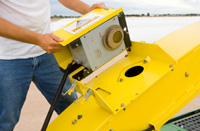We continue to see more about precision farming in the news. Michelle Koetters, Pantagraph, writes about a recent Japanese visit to the U.S. where they saw precision farming in action:
A group of Japanese agribusiness professionals took turns in the passenger seat of a tractor as the farm machinery virtually drove itself in a straight line. The miracle was the tractor’s high-tech global positioning system at work.
Todd Taylor, a representative of John Deere in Jacksonville, set the tractor’s GPS so the machine would drive along a line within an inch of perfection Monday, Oct. 1st, at the Illinois State University research farm in Lexington.
Visitor Kuniyoshi Takahashi was impressed with the accuracy.
“I think that’s great,” Takahashi, department manager of the fertilizer and inorganic chemicals department of Mitsubishi International Corp. in New York. “Sooner or later, even in Japan, it might be popular, especially on Hokkaido Island.”
The Japanese delegation arrived in Chicago on Saturday and will be in the United States for 10 days, Beatty said. ISU’s agriculture department hosted the group for a one-day tour in the Bloomington-Normal area, which included the lesson on precision agriculture at the ISU farm, as well as stops to see a farmer harvesting and a visit to a fertilizer plant.
Eight of the agribusiness professionals weree from Hokkaido, the northernmost island of Japan. It also has the richest farmland and the largest farms, said Donald Beatty, a consultant for Mitsubishi International Corp. in Tennessee.
Visit the official John Deere site for more information about John Deere Ag Management Solutions.

 Not much rain in Gibbon, Minnesota this season either, according to ASA/John Deere Reach for the Stars winner Peter Kramer who farms about 1100 acres of mainly corn and soybeans.
Not much rain in Gibbon, Minnesota this season either, according to ASA/John Deere Reach for the Stars winner Peter Kramer who farms about 1100 acres of mainly corn and soybeans.
 The International Society for Horticultural Science, the International Society of Citriculture, the American Society of Agricultural and Biological Engineers, and the University of Florida Citrus Research and Education Foundation are holding an International Symposium on
The International Society for Horticultural Science, the International Society of Citriculture, the American Society of Agricultural and Biological Engineers, and the University of Florida Citrus Research and Education Foundation are holding an International Symposium on  At the just completed World Dairy Expo one of the exhibitors was Chuck Endres,
At the just completed World Dairy Expo one of the exhibitors was Chuck Endres, 
 That information can be used to adjust the harvesting rate to the receiving rate at the bunker silo so you can adjust packing tractors or other required applications. “Also, how much inoculant or some other kind of crop treatment that you want to apply can be more accurately applied,” said Buchs.
That information can be used to adjust the harvesting rate to the receiving rate at the bunker silo so you can adjust packing tractors or other required applications. “Also, how much inoculant or some other kind of crop treatment that you want to apply can be more accurately applied,” said Buchs. This week a couple of your Precision.AgWired.com editors will be attending the
This week a couple of your Precision.AgWired.com editors will be attending the